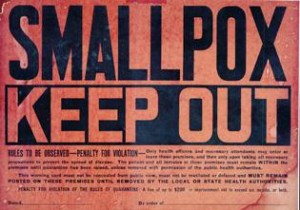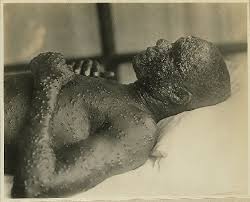The smallpox virus found in a freezer at the National Institutes of Health laboratory reminds us that the deadly virus, which was declared “eradicated” in 1980 can still be an issue for mankind.

This virus was one of the first diseases to have a vaccine. Outbreaks of smallpox killed about one third of the people who contracted the virus. It is not as contagious as influenza, but can spread easily from one infected person to another. My mother still has scaring on her back from having been infected with this in the 1930’s. Symptoms include a high fever, fatigue, and then the “pox” or vesicles of infected fluid lesions that ooze and, if the patient survives, will crust over and scar are left.

The virus left its victims with fluid filled pox that were infected. One third of the patients died.
The last known case of the virus was in 1978 in England, and one of the more famous people who died included Pocahontas, Queen Mary the Second in 1694, Peter the Second of Russia, and a host of others.
The concern about smallpox falling into the hands of terrorists as a biological weapon has led some to ask that all remaining samples of the virus be destroyed. Should the virus fall into the wrong hands it could make a potent weapon, especially if it were aerosolized and spread over a populated area.
The vials of virus were kept sealed in an ultra-cold freezer in an area that had previously been used for virus research. By agreement all known smallpox samples are kept in two secure facilities in the world, on at the Centers for Disease Control in Atlanta and the other at the State Research Center of Virology and Biotechnology in Russia.
Finding this virus among an old freezer unit, labeled, as variola – the most virulent type of smallpox, is the biologic equivalent of finding a copy of the Declaration of Independence in your attic. This sample appears to have been there since the 1950’s- records are long since lost and the researchers of that time have deceased. This did prompt a check of all other facilities on that campus, and no other samples.
The samples were sent to CDC in Atlanta for testing. It is highly likely that the samples are still capable of causing infection.
One can imagine that in some other laboratory, on some university campus somewhere, a freezer containing old discarded vials of this deadly scourge might remain. It makes you wonder if we need to keep vaccines available for the future.
